
On this page, we have provided all the information about DEA and Transportation that may be interesting and useful to users. This page contains the following sections:
1. Background
2. Key papers
3. New interesting papers
4. Related subject
5. Statistics
6. References
Highlights:
•
•
•
• Barros and Dieke: " This article has investigated the statistical foundation of using DEA in the context of airport efficiency modeling".
BACKGROUND
DEA can be roughly defined as a non-parametric method for measuring the efficiency of a decision-making unit (DMU) with multiple inputs and/or multiple outputs. This is achieved by constructing a single “virtual” output to a single “virtual” input without predefining a production function. DEA has also been used to evaluate the performance of public transit systems. Some studies evaluated the performance of airlines, airports, or airport authorities. Schefczyk (1993) is the leading article for air transportation, measuring the operational performance of 15 international airlines.
This article laid out the model for future efficiency studies on the airline industry. Other articles such as Gillen (1997), Pels (2003), Sarkis (2004) and Barros (2008) applied standard and variations of the DEA model to examine efficiencies. Barros investigated the statistical foundation of using DEA in the context of airport efficiency modelling.
Some Studies examined the efficiencies of ground transportation systems such as railway and bus. Oum and Yu (1994), which studied the efficiency of the railway system in 19 OECD countries, leads the stream for ground transportation systems studies. Subsequent works such as Odeck (2001) and Holvad (2004) studied the efficiencies of bus systems.
Some Studies examined the efficiencies of the public transit agencies. For example, Chu (1992) compare transit agencies operating in the USA, whereas Boile (2001) evaluates public transit agencies. Nolan (1996) applies DEA to evaluate the efficiency of mid-sized transit agencies in the USA using the data from Section 15 US DOT 1989–1993. Cowie and Asenova (1999) examine the British bus industry in light of fundamental reform in ownership and regulation. Very little research has focused on the evaluation of performance at the transportation process level. Notable exceptions include the evaluation of two-way intersections by Kumar (2002), the prioritization of highway accident sites by Cook (2001), and bus routes by Sheth (2007).
KEY PAPERS
This section introduces key papers in the DEA and Transportation. These papers have had a significant impact on the DEA and its application in transit sector.
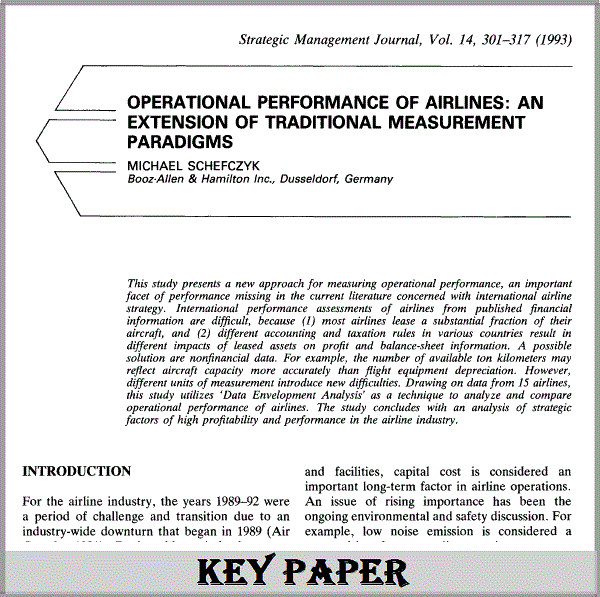
Operational performance of airlines: An extension of traditional measurement paradigms
Author: Michael Schefczyk
Journal: Strategic Management Journal
Published: 1993
Abstract: This study presents a new approach for measuring operational performance, an important facet of performance missing in the current literature concerned with international airline strategy. International performance assessments of airlines from published financial information are difficult, because (1) most airlines lease a substantial fraction of their aircraft, and (2) different accounting and taxation rules in various countries result in different impacts of leased assets on profit and balance‐sheet information. A possible solution are nonfinancial data. For example, the number of available ton kilometers may reflect aircraft capacity more accurately than flight equipment depreciation. However, different units of measurement introduce new difficulties. Drawing on data from 15 airlines, this study utilizes 'Data Envelopment Analysis' as a technique to analyze and compare operational performance of airlines. The study concludes with an analysis of strategic factors of high profitability and performance in the airline industry.
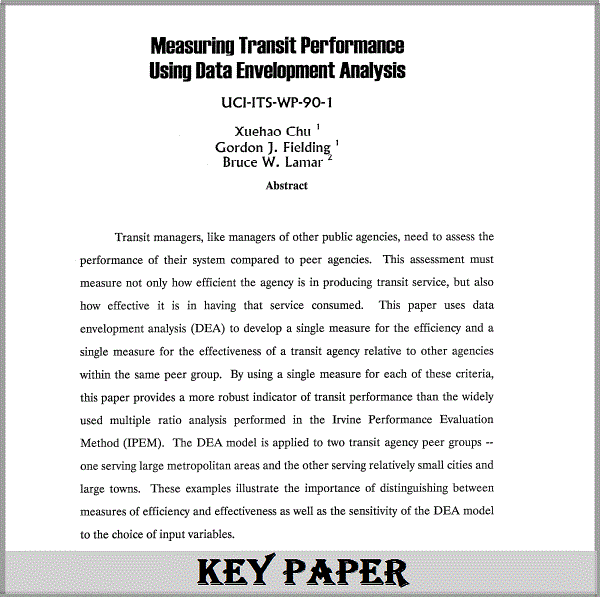
Measuring transit performance using data envelopment analysis
Authors: Chu X, Fielding G.J, Lamar B
Journal: Transport Res Part A: Pol Pract
Published: 1992
Abstract: Transit, like managers of other public agencies, need to assess the performance of their system compared to peer agencies. This assessment must measure not only how efficient the agency is in producing transit service, but also how effective it is in having that service consumed. This paper uses data envelopment analysis (DEA) to develop a single measure for the efficiency and a single measure for the effectiveness of a transit agency relative to other agencies within the same peer group. By using a single measure for each of these criteria, this paper provides a more robust indicator of transit performance than the widely used multiple ratio analysis performed in the Irvine Performance Evaluation Method(IPEM). The DEA model is applied to two transit agency peer group-one serving large metropolitan areas and the other serving relatively small cities and large towns. These examples illustrate the importance of distinguishing between measures of efficiency and effectiveness as well as the sensitivity of the DEA model to the choice of input variables.
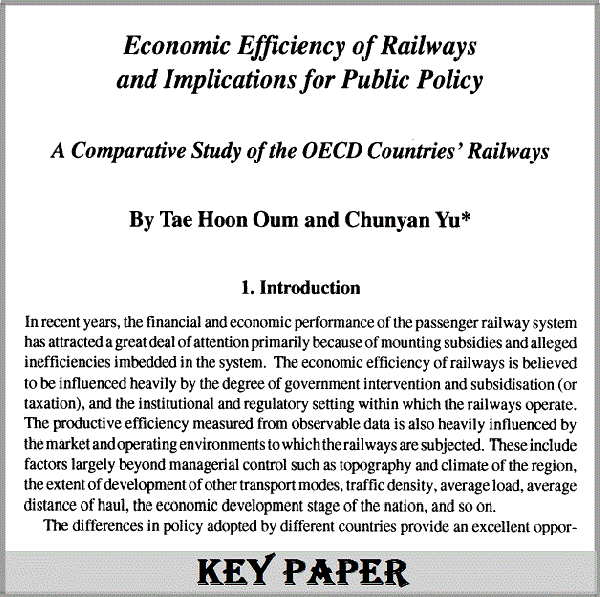
Economic-efficiency of railways and implications for public policy—a comparative study of the OECD countries railways
Authors: Oum T.H, Yu C.Y
Journal: Journal of Transport Economics and Policy
Published: 1994
Abstratct: This paper attempts to identify the effects of government intervention and subsidisation on the productive efficiency of those railways which derive a high proportion of their business from passenger services. In particular, the productive efficiency of the railway systems in 19 OECD countries is measured and analysed in order to identify the effects of both public subsidies and the degree of managerial autonomy on efficiency. The empirical results show that: (i) railway systems with high dependence on public subsidies are significantly less efficient than similar railways with less dependence on subsidies; (ii) railways with a high degree of managerial autonomy from regulatory authorities tend to achieve higher efficiency.
Determinants of productive efficiency in urban transit
Author: Nolan J.F.
Journal: Logist Transport Rev
Published: 1996
Abstract: Using data from a group of mid-sized bus transit agencies in the United States, this paper measures agency level technical efficiency with non-parametric frontier analysis (data envelopment analysis or DEA). The analysis is supplemented by a second stage regression of agency characteristics on the technical efficiency scores. The interpretations of the empirical results accord with a number of previous findings about determinants of cost efficiency in U.S. transit agencies.
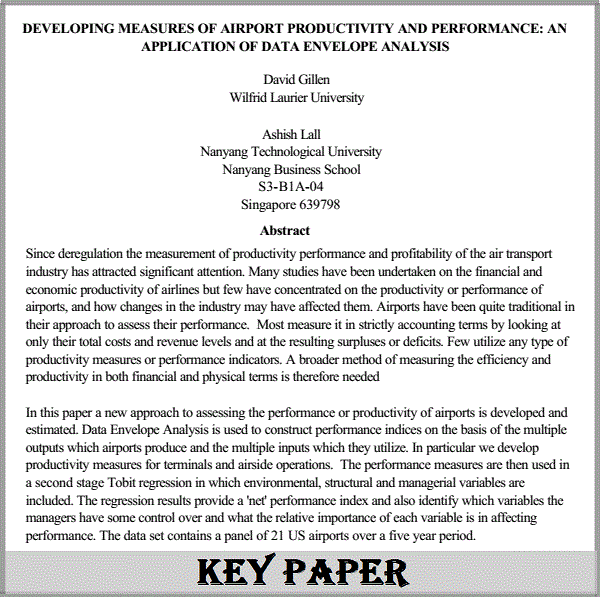
Developing measures of airport productivity and performance: an application of data envelope analysis
Author: David Gillen
Journal: Transportation Research Part E-Logistics and Transportation Review
Published: 1997
Abstract: Since deregulation the measurement of productivity performance and profitability of the air transport industry has attracted significant attention. Many studies have been undertaken on the financial and economic productivity of airlines but few have concentrated on the productivity or performance of airports, and how changes in the industry may have affected them. Airports have been quite traditional in their approach to assess their performance. Most measure it in strictly accounting terms by looking at only their total costs and revenue levels and at the resulting surpluses or deficits. Few utilize any type of productivity measures or performance indicators. A broader method of measuring the efficiency and productivity in both financial and physical terms is therefore needed. In this paper a new approach to assessing the performance or productivity of airports is developed and estimated. Data Envelope Analysis is used to construct performance indices on the basis of the multiple outputs which airports produce and the multiple inputs which they utilize. In particular we develop productivity measures for terminals and airside operations. The performance measures are then used in a second stage Tobit regression in which environmental, structural and managerial variables are included. The regression results provide a 'net' performance index and also identify which variables the managers have some control over and what the relative importance of each variable is in affecting performance. The data set contains a panel of 21 US airports over a five year period.
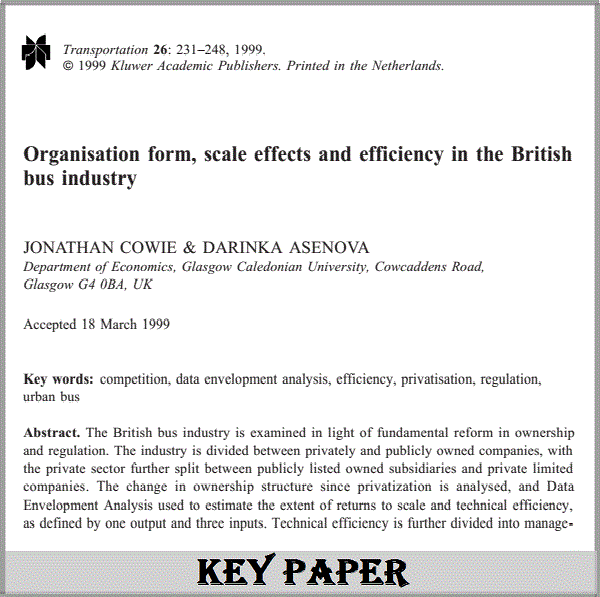
Organization form, scale effects and efficiency in the British Bus industry
Authors: Cowie J, Asenova D
Journal: Transportation
Published: 1999
Abstract. The British bus industry is examined in light of fundamental reform in ownership and regulation. The industry is divided between privately and publicly owned companies, with the private sector further split between publicly listed owned subsidiaries and private limited companies. The change in ownership structure since privatization is analysed, and Data Envelopment Analysis used to estimate the extent of returns to scale and technical efficiency, as defined by one output and three inputs. Technical efficiency is further divided into managerial and organisational components, and comparisons made of median efficiency levels using a Mann Whitney statistical test. Increasing returns to scale are found for smaller companies, but the size of such returns varies with the company type. A minimum efficiency scale is identified, with constant returns above this point. A high degree of technical inefficiency is found to be present in the industry, which may initially suggest a lack of competition and reflect the oligopolistic structure that has emerged since privatisation. Privately owned companies are identified as more technically efficient, however this is due to significantly less organisational constraints, and considerable managerial inefficiency exists in this group. It is finally concluded that the high level of inefficiency may not reflect ownership, but rather industry characteristics, and rather than a lack of competition may be indicative of wasteful competition. It is suggested therefore there may be a need to make the market contestable rather than openly competitive.
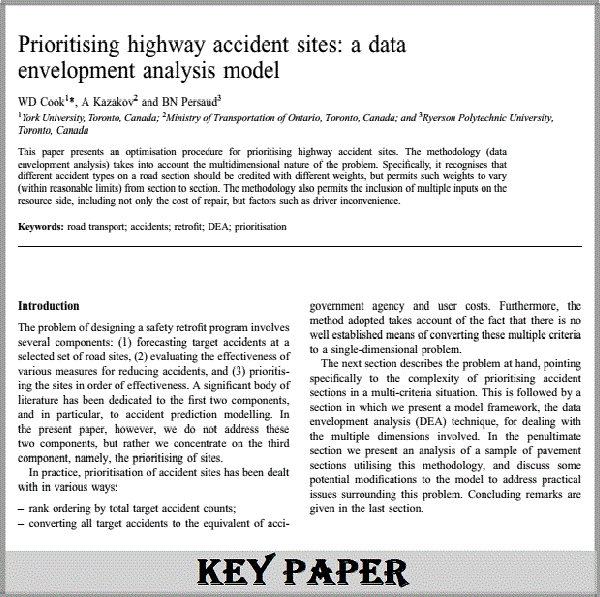
Prioritizing highway accident sites: a data envelopment analysis model
Authors: Cook W.D, Kazakov A, Persaud B.N.
Journal: Journal of the Operational Research Society
Published: 2001
Abstract: This paper presents an optimisation procedure for prioritising highway accident sites. The methodology (data envelopment analysis) takes into account the multidimensional nature of the problem. Specifically, it recognises that different accident types on a road section should be credited with different weights, but permits such weights to vary (within reasonable limits) from section to section. The methodology also permits the inclusion of multiple inputs on the resource side, including not only the cost of repair, but factors such as driver inconvenience.
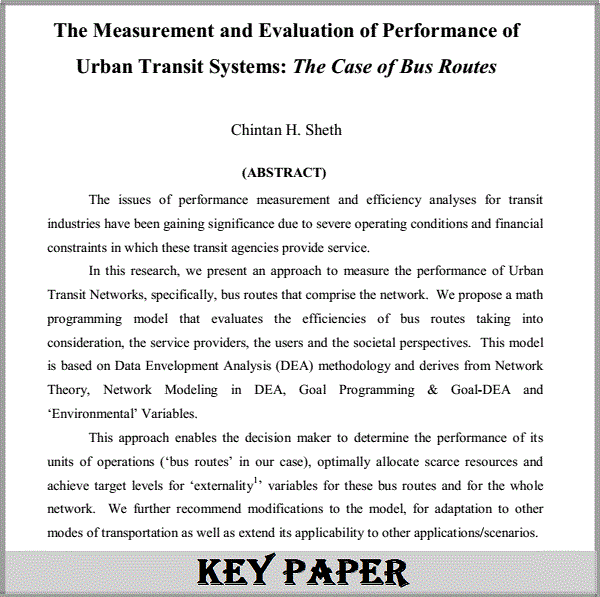
The measurement and evaluation of performance of urban transit systems: the provision of Bus service along different routes
Authors: Sheth C, Triantis K, Teodorovic ´ D
Journal: Transport Res: Part E
Published: 2007
Abstract: The issues of performance measurement and efficiency analyses for transit industries have been gaining significance due to severe operating conditions and financial constraints in which these transit agencies provide service. In this research, we present an approach to measure the performance of Urban Transit Networks, specifically, bus routes that comprise the network. We propose a math programming model that evaluates the efficiencies of bus routes taking into consideration, the service providers, the users and the societal perspectives. This model is based on Data Envelopment Analysis (DEA) methodology and derives from Network Theory, Network Modeling in DEA, Goal Programming & Goal-DEA and 'Environmental' Variables. This approach enables the decision maker to determine the performance of its units of operations ('bus routes' in our case), optimally allocate scarce resources and achieve target levels for 'externality' variables for these bus routes and for the whole network. We further recommend modifications to the model, for adaptation to other modes of transportation as well as extend its applicability to other applications/scenarios.
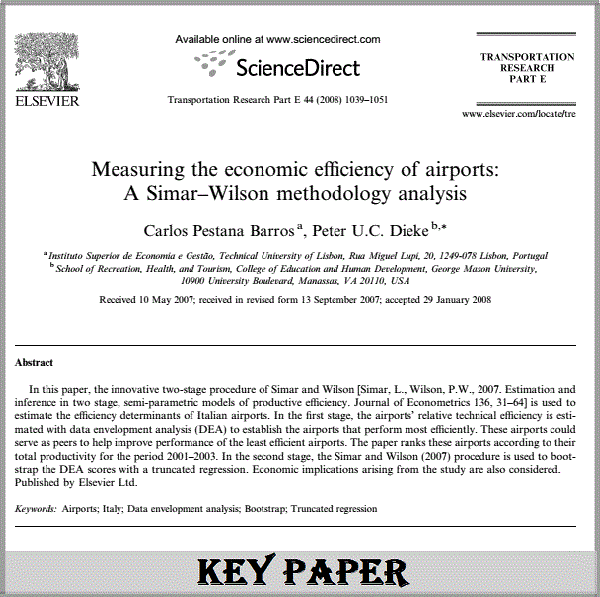
Measuring the economic efficiency of airports: A Simar–Wilson methodology analysis
Author: Carlos Pestana Barros, Peter U.C. Dieke
Journal: Transportation Research Part E
Published: 2008
Abstract: In this paper, the innovative two-stage procedure of Simar and Wilson [Simar, L., Wilson, P.W., 2007. Estimation and inference in two stage, semi-parametric models of productive efficiency. Journal of Econometrics 136, 31–64] is used to estimate the efficiency determinants of Italian airports. In the first stage, the airports’ relative technical efficiency is estimated with data envelopment analysis (DEA) to establish the airports that perform most efficiently. These airports could serve as peers to help improve performance of the least efficient airports. The paper ranks these airports according to their total productivity for the period 2001–2003. In the second stage, the Simar and Wilson (2007) procedure is used to bootstrap the DEA scores with a truncated regression. Economic implications arising from the study are also considered.
NEW INTERESTING PAPERS
The using of the DEA technique in the Transportation sector is increasing over time. This section introduces new articles that present a new method or significant results in this area.
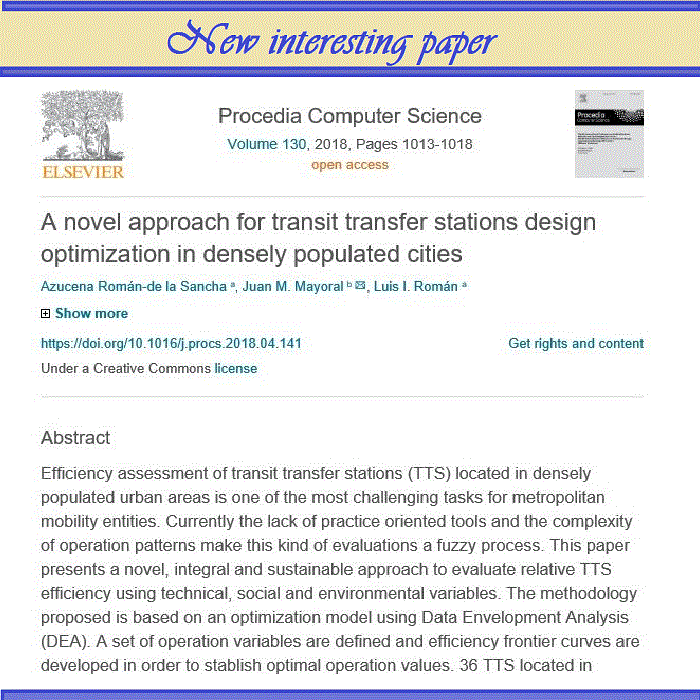
A novel approach for transit transfer stations design optimization in densely populated cities
Authors: Azucena Román-dela Sancha , Juan M.Mayoral , Luis I.Román
Journal: Procedia Computer Science
Published: 2018
Abstract: Efficiency assessment of transit transfer stations (TTS) located in densely populated urban areas is one of the most challenging tasks for metropolitan mobility entities. Currently the lack of practice oriented tools and the complexity of operation patterns make this kind of evaluations a fuzzy process. This paper presents a novel, integral and sustainable approach to evaluate relative TTS efficiency using technical, social and environmental variables. The methodology proposed is based on an optimization model using Data Envelopment Analysis (DEA). A set of operation variables are defined and efficiency frontier curves are developed in order to stablish optimal operation values. 36 TTS located in Mexico City Metropolitan Area (MCMA) are presented as case study. Findings point that TTS medium size stations are more suitable to reach a better balance among technical, social and environmental objectives. This methodology represents a useful tool to assess the different operational elements of TTS to improve the whole station efficiency.
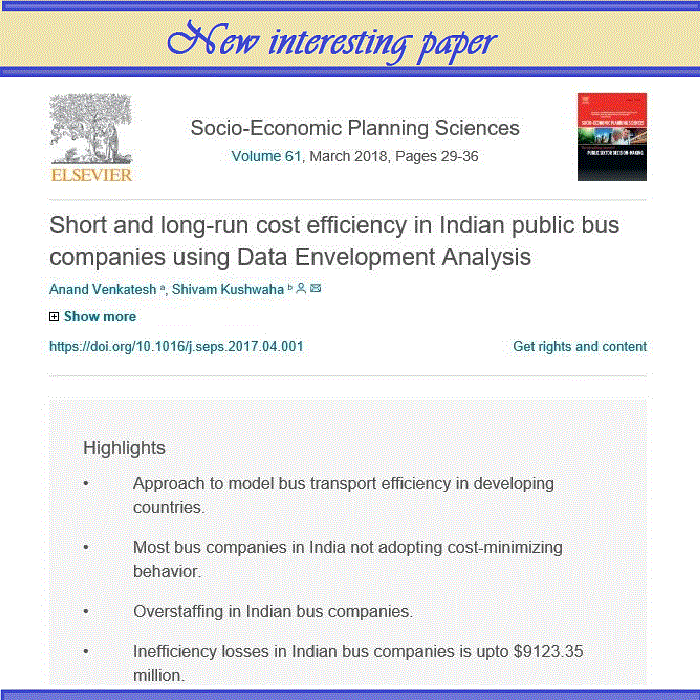
Short and long-run cost efficiency in Indian public bus companies using Data Envelopment Analysis
Authors: Venkatesh, A., S. Kushwaha
Journal: Socio-Economic Planning Sciences
Published: 2018
Abstract: State Transport Undertakings (STUs) are key players in providing mass road transport in India. Given that they operate under high levels of government imposed regulatory constraints, it is imperative to study their efficiency levels. Given that capital is a relatively scarce resource in developing countries like India, it is important to obtain efficiency in the short-run where some inputs are fixed as well as over the long run, where all inputs are variable. The technique used for capturing efficiency is Data Envelopment Analysis (DEA). A key possible limitation of DEA models based on physical inputs and outputs is that for an inefficient firm, reduction in some or all inputs may be recommended. It may often be desirable for an inefficient firm to increase some less expensive inputs while reducing the use of relatively expensive ones. Hence, when market price data is available, it is advisable to use the cost variant of DEA. Also, it is possible to determine variable cost efficiency in the short run when some inputs cannot be varied. Such inputs are referred to as “quasi-fixed” inputs. In this paper, we examine short and long term efficiencies of select bus companies in India known as State Transport Undertakings (STUs) over a period of 10 years. Fleet strength has been used as the quasi-fixed input. It is possible to ascertain, through a comparison of shadow price of the quasi-fixed input, vis-à-vis its market price, as to whether the quantity of this input is sub-optimally small or large. It is found that by adopting efficiency enhancing practices, STUs can cumulatively reduce their operating costs to the extent of 9123.35 million dollars. Also the tendency to minimize costs is found to be declining over time. In the short run some STUs are found to operate with a sub optimally low fleet size.
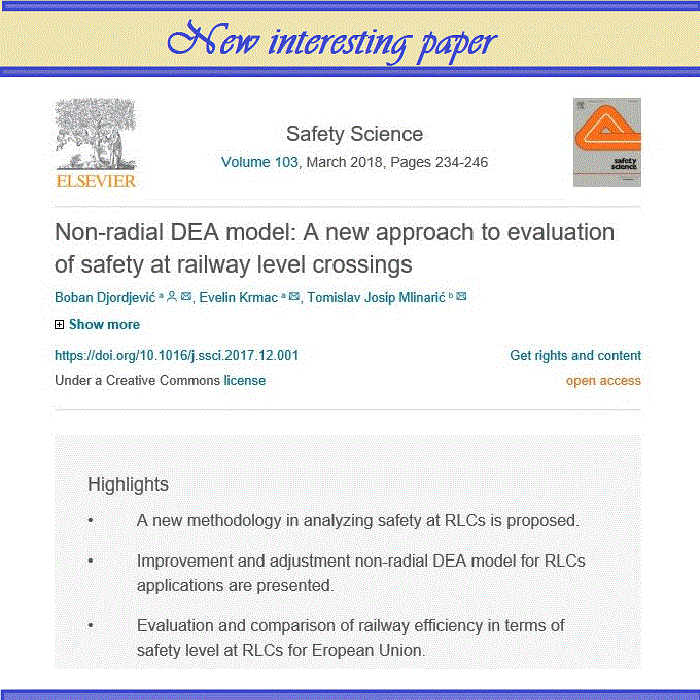
Non-radial DEA model: A new approach to evaluation of safety at railway level crossings
Authors: Djordjević, B., E. Krmac, T. J. Mlinarić
Journal: Safety Science,
Published: 2018
Abstract: Railway level crossings (RLCs) are critical points characterized by a large number of accidents per year due to the intersection of railway and roadway infrastructures. The improvement of safety at RLCs is of crucial importance worldwide. This paper proposes a new approach for evaluating safety at RLCs using non-radial DEA (Data Envelopment Analysis) model. The introduced non-radial DEA model is employed for the evaluation of railway efficiency of European countries regarding the level of safety at RLCs through considering desirable and undesirable inputs, as well as desirable and undesirable outputs for the period from 2010 to 2012 and for the year 2014. Due to missing the comprehensive set of data for roadway traffic, the evaluation of safety at railway RLCs has been conducted from railway viewpoint. Through the application of modified non-radial DEA model, results indicate the most efficient countries, as well as countries with a lower efficiency of railway performance in terms of the level of safety at RLCs. In order to check the validity of modified non-radial DEA model, comparison of results and sensitivity analysis were conducted. Despite the validity, results of the sensitivity analysis indicated also some weaknesses of the modified non-radial DEA model related to missing and inaccurate data, the number of variables included, and the selection of inputs and outputs. A modified non-radial DEA model, as proposed in the paper, with overall set of data can be used for evaluating the efficiency of safety improvement at RLCs, efficiency of different countermeasures before and after implementation at RLCs of different.
RELATED SUBJECT
STATISTICS
In this section, we list a series of selected descriptive statistics involving the numbers and distributions of papers, journals and keywords of DEA and health care related articles during the years 1983 to 2018.
1. Statistics involving publications by year
2. Statistics involving publications by journal
3. Statistics involving keywords used
The following table lists the most popular keywords by number of publications.
REFERENCES